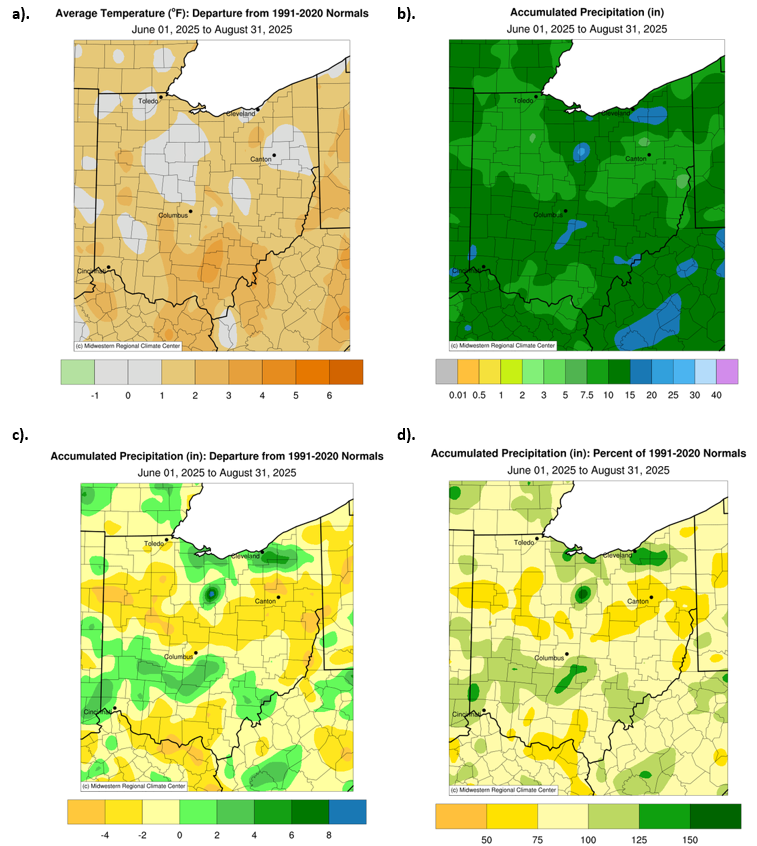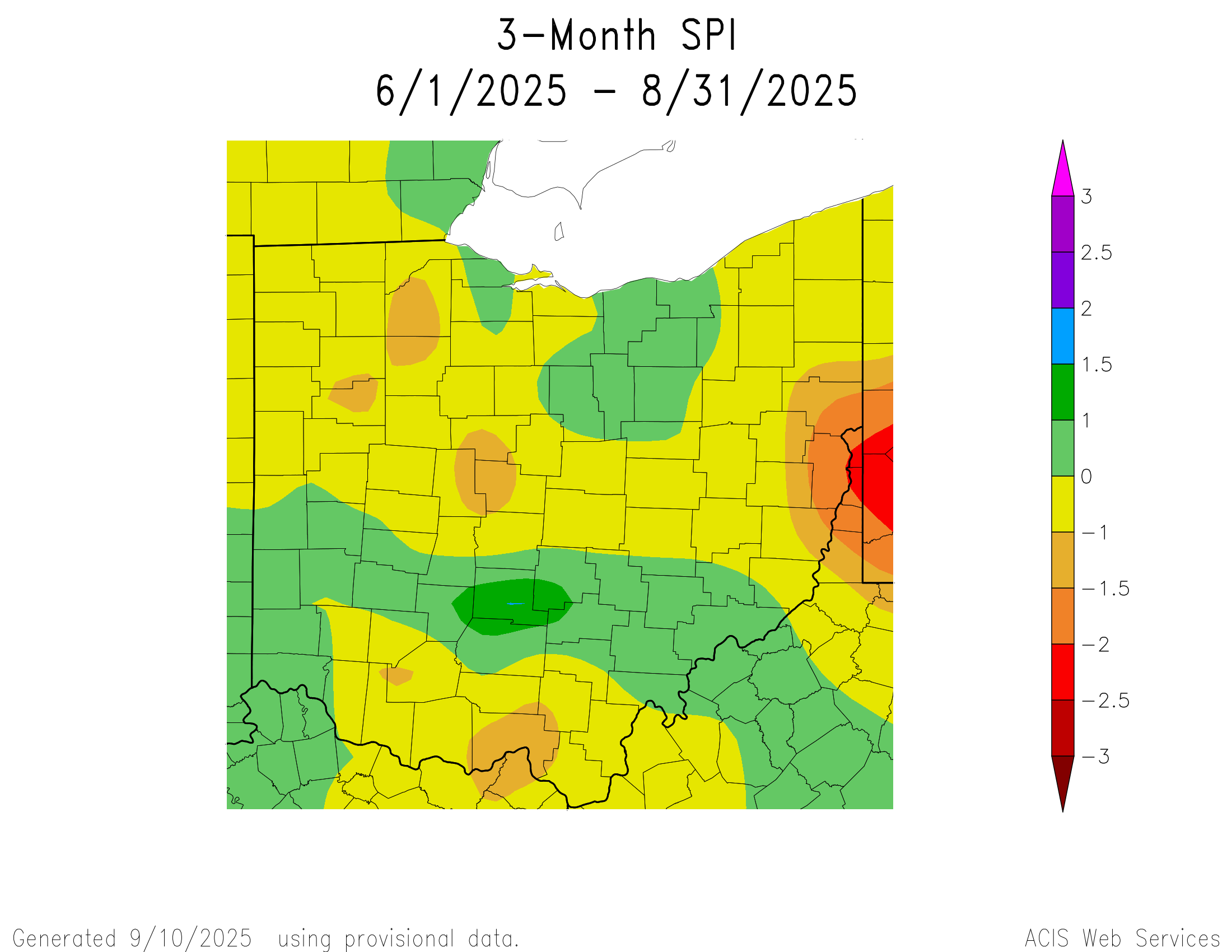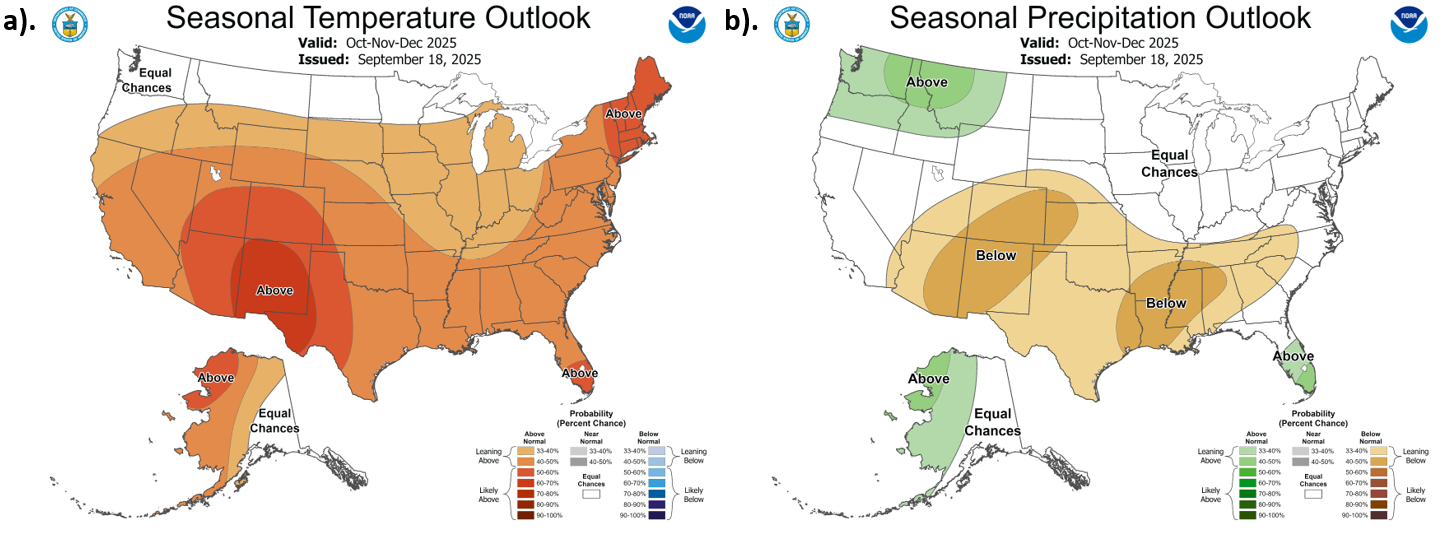Provided by the State Climate Office of Ohio, a collaboration of the Byrd Polar and Climate Research Center, Geography Department, and OSU Extension with support from Energent Solutions.
Temperature and Precipitation
This summer in Ohio was characterized by above-average temperatures and notable variability in precipitation departures from normal. Average temperatures across most of the state were 0–1°F above normal, with localized areas of 1–2°F above normal and a small region in southern Ohio reaching 2–3°F above normal (Fig. 1a). For precipitation, most of Ohio received 7.5–15 inches of rainfall, with isolated pockets accumulating 15–20 inches (Fig. 1b). The departure-from-normal precipitation map highlights this variability. Much of the state was 0–4 inches below normal, though bands of 0–4 inches above normal appeared south of Columbus and in the Cleveland area (Fig. 1c). Similarly, the percent-of-normal map shows most of Ohio at 75–100% of normal precipitation, with scattered sections of 50–75% in the north and southwest, and areas of 100–150% of normal south of Columbus and around Cleveland (Fig. 1d). The small regions of higher anomalies are a result of localized, extremely heavy or repeated precipitation from strong storms.

Soil and Energy
The 3-month Standardized Precipitation Index (SPI) indicates near-normal moisture conditions for most of Ohio during the summer. Most of the state recorded SPI values of –1 to 1 which indicates near normal soil conditions, with small pockets of –1 to –1.5 indicating drier than normal conditions and 1 to 1.5 indicating wetter than normal conditions. A region of –1 to –2.5 SPI values extended into the center of Ohio’s eastern border indicated a region of extreme dryness (Fig. 2). These values suggest that while broad conditions were close to normal, localized areas experienced more notable dryness or wetness.

Warmer-than-normal temperatures resulted in a higher number of cooling degree days (CDDs) and a lower number of heating degree days (HDDs). Departures from normal were +90 to +150 for CDDs and –15 to –35 for HDDs (Fig. 3). These increased temperatures likely led to higher demand for air conditioning throughout the summer, raising overall energy use in Ohio.

Looking Ahead
The Climate Prediction Center’s (CPC) seasonal outlook suggests a warm autumn for Ohio. The temperature outlook predicts above-normal temperatures across the entire state, with generally low confidence overall and slightly higher confidence in eastern Ohio (Fig. 4a). The precipitation outlook indicates equal chances of above- or below-normal precipitation over the next three months (Fig. 4b).

Note: these outlooks do not provide the quantity of above or below normal conditions, just the likelihood of occurrence (i.e., the probability).
Overall, these forecasts are consistent with recent seasonal trends, with the only notable change being a slight decrease in confidence for the temperature outlook. Warmer-than-normal conditions could extend the growing season for some crops, providing additional time for late harvests and potentially benefiting farmers. At the same time, the reduced need for early-season heating may temporarily lower energy demand, although swings in daily temperatures could still create short-term variability in usage.
Authors
Aiden Ridgway: Atmospheric Sciences Undergraduate, Student Assistant: Climate Services - Byrd Polar and Climate Research Center, The Ohio State University, ridgway.72@osu.edu
Alexis Jahnke: Atmospheric Sciences Undergraduate, Student Assistant: Climate Services - Byrd Polar and Climate Research Center, The Ohio State University, jahnke.30@osu.edu
Geddy R. Davis: Meteorologist/Atmospheric Scientist, Program Coordinator: Climate Services - Byrd Polar and Climate Research Center, The Ohio State University, davis.5694@osu.edu
Aaron B. Wilson: State Climate Office of Ohio, Byrd Polar and Climate Research Center & OSU Extension, The Ohio State University, wilson.1010@osu.edu
